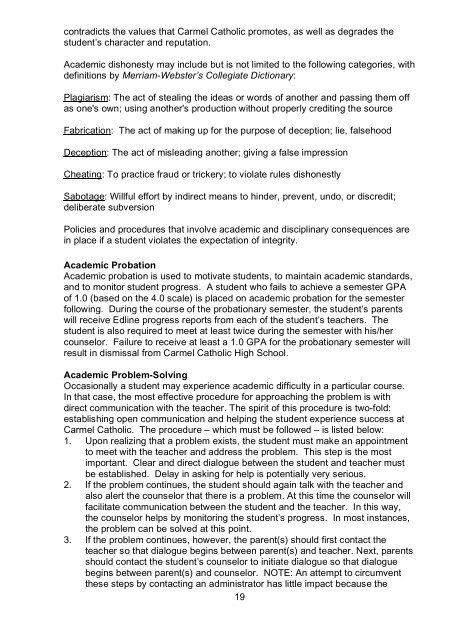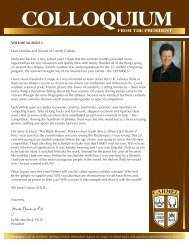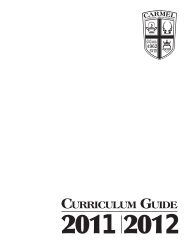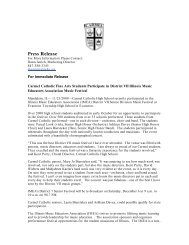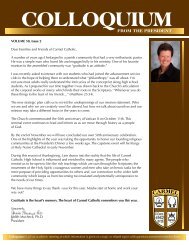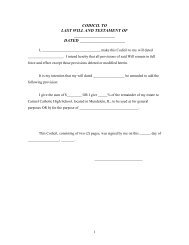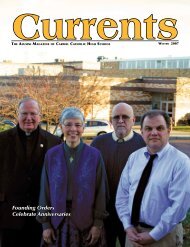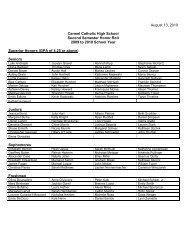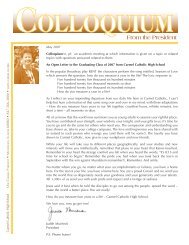CARMEL CATHOLIC HIGH SCHOOL
CARMEL CATHOLIC HIGH SCHOOL
CARMEL CATHOLIC HIGH SCHOOL
Create successful ePaper yourself
Turn your PDF publications into a flip-book with our unique Google optimized e-Paper software.
contradicts the values that Carmel Catholic promotes, as well as degrades the<br />
student’s character and reputation.<br />
Academic dishonesty may include but is not limited to the following categories, with<br />
definitions by Merriam-Webster’s Collegiate Dictionary:<br />
Plagiarism: The act of stealing the ideas or words of another and passing them off<br />
as one's own; using another's production without properly crediting the source<br />
Fabrication: The act of making up for the purpose of deception; lie, falsehood<br />
Deception: The act of misleading another; giving a false impression<br />
Cheating: To practice fraud or trickery; to violate rules dishonestly<br />
Sabotage: Willful effort by indirect means to hinder, prevent, undo, or discredit;<br />
deliberate subversion<br />
Policies and procedures that involve academic and disciplinary consequences are<br />
in place if a student violates the expectation of integrity.<br />
Academic Probation<br />
Academic probation is used to motivate students, to maintain academic standards,<br />
and to monitor student progress. A student who fails to achieve a semester GPA<br />
of 1.0 (based on the 4.0 scale) is placed on academic probation for the semester<br />
following. During the course of the probationary semester, the student’s parents<br />
will receive Edline progress reports from each of the student’s teachers. The<br />
student is also required to meet at least twice during the semester with his/her<br />
counselor. Failure to receive at least a 1.0 GPA for the probationary semester will<br />
result in dismissal from Carmel Catholic High School.<br />
Academic Problem-Solving<br />
Occasionally a student may experience academic difficulty in a particular course.<br />
In that case, the most effective procedure for approaching the problem is with<br />
direct communication with the teacher. The spirit of this procedure is two-fold:<br />
establishing open communication and helping the student experience success at<br />
Carmel Catholic. The procedure – which must be followed – is listed below:<br />
1. Upon realizing that a problem exists, the student must make an appointment<br />
to meet with the teacher and address the problem. This step is the most<br />
important. Clear and direct dialogue between the student and teacher must<br />
be established. Delay in asking for help is potentially very serious.<br />
2. If the problem continues, the student should again talk with the teacher and<br />
also alert the counselor that there is a problem. At this time the counselor will<br />
facilitate communication between the student and the teacher. In this way,<br />
the counselor helps by monitoring the student’s progress. In most instances,<br />
the problem can be solved at this point.<br />
3. If the problem continues, however, the parent(s) should first contact the<br />
teacher so that dialogue begins between parent(s) and teacher. Next, parents<br />
should contact the student’s counselor to initiate dialogue so that dialogue<br />
begins between parent(s) and counselor. NOTE: An attempt to circumvent<br />
these steps by contacting an administrator has little impact because the<br />
19


